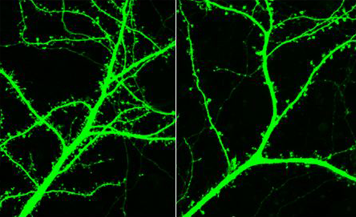 |
| Dr. Jane Flinn |
Our lecturer
this week was Dr. Jane M. Flinn, director of undergraduate neuroscience program
at George Mason University. Dr. Flinn's current research focuses on the role of
metals in normal memory and in Alzheimer's disease (AD). The brain of those
with AD contains plaques and tangles. The plaques contain amyloid, a protein
which is aggregated by zinc, but which also binds copper and iron.
Recently, she
observed elevated levels of zinc, iron and copper in the plaques found in
brains of people with AD. The transgenic
mice she experimented with carried an APP mutation so unlike most mice, they
developed plaques. By administering different levels of metals in their drinking
water, her team's results showed "both zinc and iron significantly
impaired spatial memory in mice modeling early onset AD but copper partially
remediated the zinc effect." Additionally, increased zinc diminishes the
ability to learn that a stimulus is no longer fearful in normal mice and rats.
This effect can be a model of post-traumatic stress disorder (PTSD). Small
amounts of copper have been shown to partially alleviate these symptoms. Perhaps
learning impairment could be a result of copper deficiency?
 |
| A soldier affected by PTSD |
Previous
research have demonstrated chronic stress decreases zinc in the blood while
increases it in the brain. This suggests zinc might be redistributed from the
blood to the brain. Results from other previous research showed excess zinc
both pre and post-natally demonstrated impairments in fear extinction thus zinc
may be a mediator between stress and the inability to extinguish fear.
Dr. Flinn conducted
the experiment, The Effects of Chronic Unpredictable Stress (CUS) on the
Ability to Extinguish Fear: Zinc as a Mediator, where they collected data from
mice given zinc and measured impairments in fear extinction. The subjects were
31 Sprague-Dawley rats bred both pre and post-natally on either water enhanced
with zinc (10mg/kg ZnCO3) or tap water. The four groups were: tap water +
stress (control), tap water + stress, zinc + no stress, zinc + stress. A 21 day
randomized chronic unpredictable stress paradigm was administered. 10 days post stress, cued fear conditioning was
conducted. Day 1: training = 3 tone + shock pairings. Day 2: extinction = 18
tones and no shock. Day 3: recall = 18 tones and no shock.
 |
| Representative metal output images. Images show iron (Fe, top left), calcium (Ca, top right), zinc (Zn, bottom left), and potassium (K, bottom right). (White color= greatest concentration). |
Dr. Flinn and
her team concluded the zinc group took longer to learn fear extinction as well
as memory deficits with impairment of recall. CUS rats showed less freezing
when anticipating shocks compared to control group. This concludes a down
regulation of the HPA axis even 10 days post termination of stress.
The work
of Dr. Flinn will guide future directions of these types of research. If increased Zinc in the diet can cause deficiency, are the deficits
in the fear conditioning due to a copper deficiency? Thus far we think
the deficits in AD are due to a copper deficiency, continuing work on developing
mouse model of late onset AD would confirm or reject this hypothesis. It is
suggested that AD is caused by an inflammation problem. Dr. Flinn mentioned an
incident where there were two identical twins and one of them took aspirin
regularly. The other developed AD 10 years sooner than the twin on the aspirin
regimen. This, again, raises new question that will hopefully be answered with
further research.
Reference
The Effects of Chronic Unpredictable Stress (CUS) on the Ability to Extinguish Fear: Zinc as a Mediator
Knaack, G.L., McDonald, C.G., & Flinn, J.M. Dept. Psychology, George Mason Univ., Fairfax, VA, USA




